I am sorry that it has taken longer than I hoped to return to this pilgrimage journal, but here at last is a glimpse of the last fortnight and a few reflections on Palm Sunday for today.
I fell asleep last night with the waxing moon shining on my face and woke to the sun lighting up my bedside altar through the east window. What better way to begin Palm Sunday and enter Holy Week. After almost a week on this most northerly Shetland isle of Unst, I have already learnt to expect any season (or indeed all of them) during any day, so was grateful for the blessing of a sunny start. It meant I could walk to the Kirk and say hello to neighbours along the way.
I have met such a warm welcome here in Shetland and those gathered for this Palm Sunday service today were no exception. I met a Quaker at the door and was given a willow wand, the more traditional version of a palm in both Scotland and England, by the Reader. I was then greeted by the Church of Scotland minister, before sitting down between a Scottish Episcopalian and an Orthodox nun… ecumenism is clearly flourishing here! To be honest I was as bowled over by the service, as I have been at times by the winds here on Unst. There was great music, beautifully simple and blessedly short prayers, heart felt Scripture reading and a cracking sermon. As a lover of wild church, I naturally warmed to a minister who pointed out that two thirds of the gospel passage about Jesus’ entry into Jerusalem actually focusses on the donkey, on whom he rides into the city.
Much as I would like to go into more detail about what I learned about the significance and symbolism of donkeys, the exploration of Roman triumphalism and its parallels in institutional church power structures (more resonance there!), the counter cultural street theatre of Jesus’ wild ride into occupied territory and the contrast between the joyful support of Jesus’ companion pilgrims and the questions of the city’s leaders… I shall exercise restraint. I am aware and can only apologise for not managing to post last Sunday, such that I have two weeks of adventures to share!
As before, I shall draw on my daily Wild Church facebook community posts and photos, to try and offer some glimpses from the last fortnight. I concluded the last post in Edinburgh, where I stayed on for the Spring Equinox, before heading to Inverness on Day 9… So here’s what happened next:
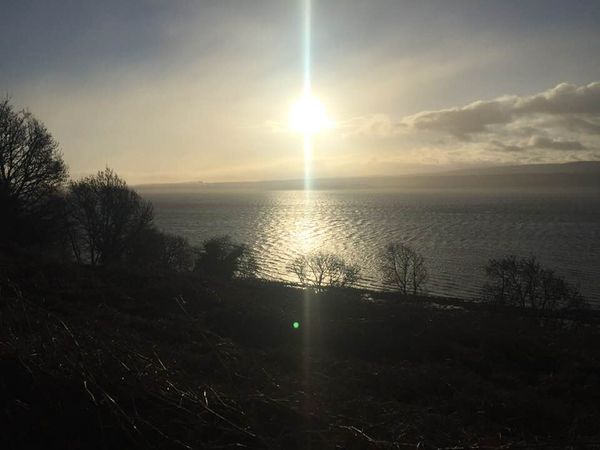
Day 10 – I am having a lovely time reconnecting with friends, Ruth & Claire, in and around the Coach House retreat centre at Kilmuir near Inverness. I started the day watching the sun rise over the Moray Firth, from the old church yard, and I could also see the seasonal shift from south to north in how the snowdrops are still blooming here. Then later Ruth led us on a wonderful walk through mature woodland with a rich understory of heather and blaeberry, and over rocky viewpoints carpeted with lichen. We wound our way through to a hidden loch as the sun was going down, with swans on the water and three red kites in the sky above. It’s so good to be back in the Highlands, which used to be my home. I’ve noticed myself relaxing, sleeping better & having more energy as I’ve got further north and the landscape has got wilder… so healing for body & soul.
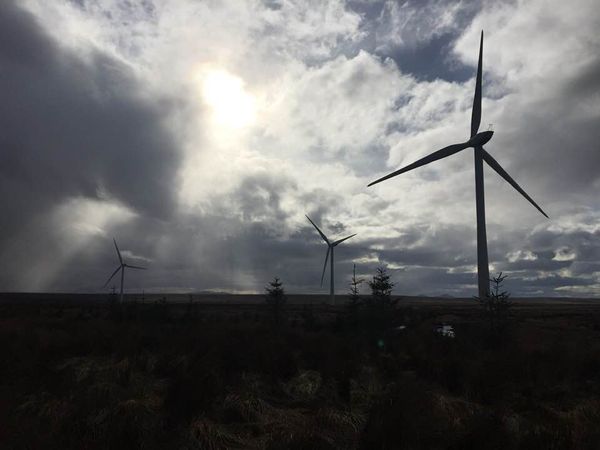
Day 11 – I broke new ground (for me) as I journeyed north of Inverness to Scrabster and then by boat to Orkney. After a meditative start in the lovely Coach House chapel, I set off up the A9, pausing at Loch Fleet Nature Reserve for an inspiring walk through the dunes and along the pale sand of the shoreline. There were so many birds and the air was full of their song, from the trilling of flocks of oyster catchers to the liquid notes of the lark. Then travelling on through the deep thrum of the wind farms to take the ferry from Scrabster, where I saw my first glimpse of the Isles. The sun was setting & the new moon rising out of the sea as we set off and then all the lights of Stromness were shining in the dark water as we arrived.
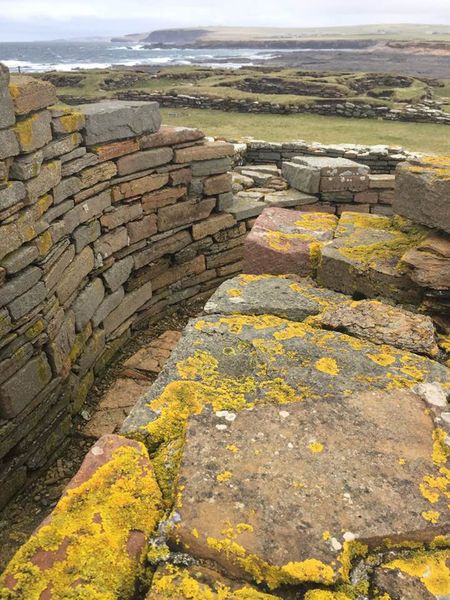
Day 12 – Today I made a ‘peregrinatio’, wandering and wondering from Stromness to a perfect wild monastery on the Brough of Birsay. On the way I paused at the Ring of Brodgar and other Neolithic sites that are 5,000 years old. I had been so looking forward to visiting these and yet I found them rather touristy and surprisingly unmoving. It was the Brough of Birsay that really inspired me. It is a tidal island and not that easy to visit, which perhaps helps… I got there as the tide was going out and staggered against the wind and over the slippery causeway to collect shells and then explore the island. It shows signs of settlement from seventh century Picts, to the eleventh century monastery. The ruins of the monastery church are so beautiful with the stone altar covered in golden lichen and the curved wall of the apse facing the crashing waves. There’s so much sacred food for the soul here on Orkney…
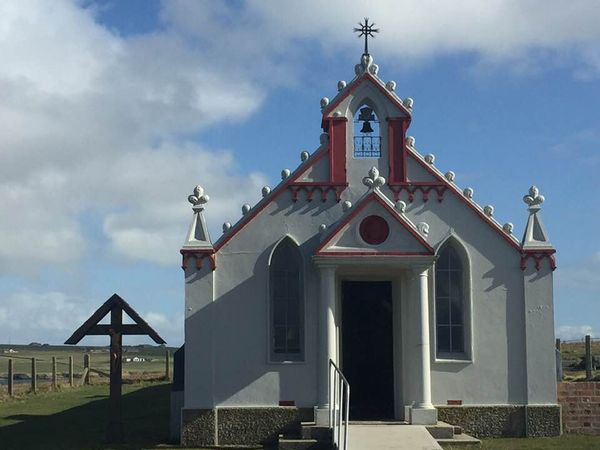
Day 13 – my last day on Orkney, as I sail for Shetland just before midnight. Today I found a strong contender for a new home base for our Wild Monastery, at Sandwick on South Ronaldsay. To get there I travelled over several islands, crossing the so called ‘Churchill Barriers’ set up during World War Two to protect the eastern approaches of Scapa Flow. The hard work of making them was done by Italian prisoners of war, who also created their own chapel on Lamb Holm out of two Nissan huts. This is a quite extraordinary sacred space (and a perfect place to visit today, on the Feast of the Annunciation), largely made simply of concrete, which was beautifully painted to create the convincing impression of stone, tiles and stained glass. Being there felt like an important reminder that the Spirit is the source of creativity and possibility, whatever challenges we face.
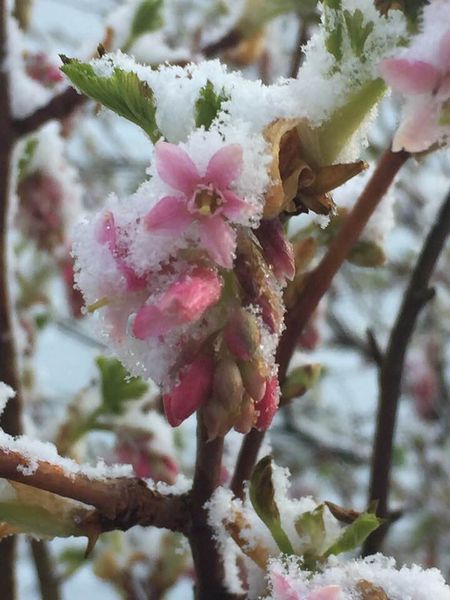
Day 14 – I arrived in Shetland off the boat early this morning. My first glimpse was of horizontal snow sweeping across the sea and land. British Summer Time begins today but here in the sub arctic (and on the same latitude as parts of Alaska) summer seems like a dream… I think the flowering currant shown below probably wishes it had waited. I have to say, I love it! My wild soul just feels strangely at home with the icy wind, the rough water and big skies, and this place seems to wake me up and makes me feel more alive.
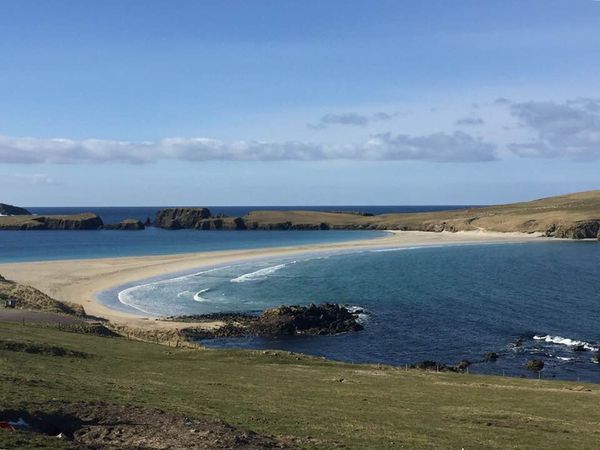
Day 15 – I scraped the snow off the car this morning to go to the beach ![]() What a beach and what a blessing to have the sun come out while I was there. This is the iconic ‘tombolo’ that crosses to St. Ninian’s Isle. Due to the freezing start to the day, I had the whole place to myself for a couple of hours. There is something quite extraordinary about walking between the waves in this way and the shapes and colours were so beautiful. The tides are still rising a fair way since the spring equinox and at high tide the gap narrowed quite considerably, even scarily (as I wasn’t sure whether the sand would be submerged). Yet I was able to wander along the tideline collecting shells & sea glass, and then around the outer edge of the island, where there are seabird colonies. I met many fulmars with their expressive dark eyes, cosying up in pairs on precipitous cliff ledges. They seemed to be constantly muttering amorous things to each other, or possibly rude comments about my passing by. Fortunately it’s early in their breeding season and they haven’t got to the protective ‘spitting foul smelling fish paste’ stage yet!
What a beach and what a blessing to have the sun come out while I was there. This is the iconic ‘tombolo’ that crosses to St. Ninian’s Isle. Due to the freezing start to the day, I had the whole place to myself for a couple of hours. There is something quite extraordinary about walking between the waves in this way and the shapes and colours were so beautiful. The tides are still rising a fair way since the spring equinox and at high tide the gap narrowed quite considerably, even scarily (as I wasn’t sure whether the sand would be submerged). Yet I was able to wander along the tideline collecting shells & sea glass, and then around the outer edge of the island, where there are seabird colonies. I met many fulmars with their expressive dark eyes, cosying up in pairs on precipitous cliff ledges. They seemed to be constantly muttering amorous things to each other, or possibly rude comments about my passing by. Fortunately it’s early in their breeding season and they haven’t got to the protective ‘spitting foul smelling fish paste’ stage yet!
The Isle is also home to another inspiring sacred site & wild church. It has a burial ground with both Pagan & Christian graves, and the ruins of the 12th century chapel have an older building beneath. Pictish silver treasure was also found here by a schoolboy in the 1950s… his day must have been as memorable as mine and yet I was equally happy to experience these wild treasures.
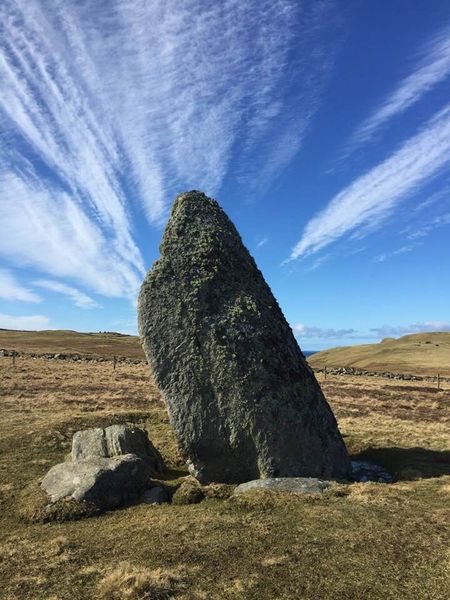
Day 16 – I have arrived at the most northerly inhabited place in the UK, the isle of Unst. I started the day by visiting The Lodberrie in Lerwick, which will be familiar to other fans of the series ‘Shetland’ and also nearby Bain beach, which must be one of the best places in the world for collecting sea glass. Then I took a ferry to the next island, Yell, and then another ferry to Unst, catching sight of some incredible clouds over the sea along the Way. Every few hundred yards here on Unst seems to reveal another layer of history. Above is just a glimpse of one… a huge standing stone I met on the way to another 12th century wild church at Lund.
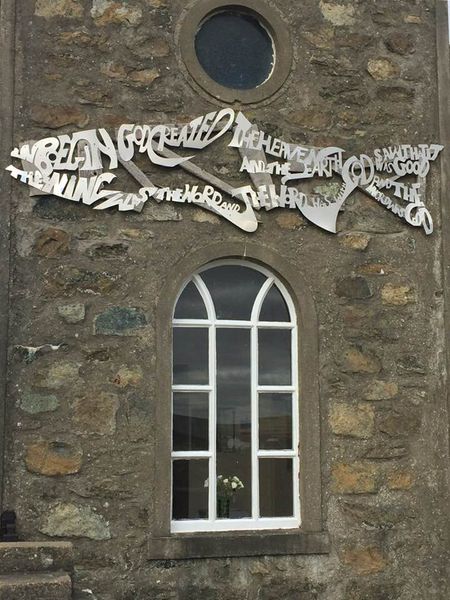
Day 17 – After a fortnight or so mostly on the move, it is good to stay close to home, here in Baliasta, Unst. Last night I stepped out of the cottage door and there was not a single light as far as I could see, just the crescent of the moon and stars that seem somehow brighter here.
Today I headed into a strong, cold wind and walked to the local store at Baltasound, which sells everything from anchors to… well, I bought a very long leek and some Tunnocks Tiffin. Along the way I stopped in at the C of S kirk with its wonderful wordy fish. I appreciate the significance of fish, both as one of the earliest Christian symbols and for this place, which was once a significant herring port. I’ve been reading that many women or ‘gutter girls’ were employed in the 18th to early 19th century, gutting & salting the ‘silver darlings’ and how this changed the lives of Shetland women, who were able to earn their own money, gain more independence and have a life outside of their usual domestic sphere.
Back home again, I enjoyed my much more relaxed domestic sphere & did some nesting, creating little prayer places with wild treasures collected on my travels and cosy corners with many blankets, for sitting, reading, snoozing… I feel a bit guilty and also grateful to be a 21st century woman, who doesn’t need to gut 60 fish a minute and can simply have some holy days…
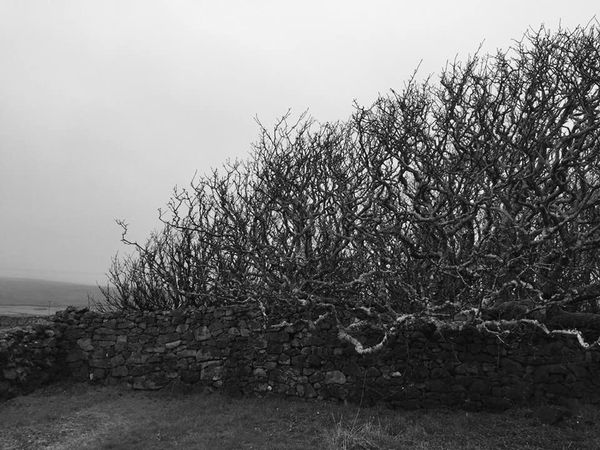
Day 18 – I staggered off into the wind and rain today in search of Britain’s most northerly wood at Halligarth, here in Unst. In a landscape with few trees, this wind sculpted third of an acre feels particularly precious… I could feel my body ease as I stepped into its shelter and no longer needed to brace against the stinging rain and sea spray. On a dull day my imagination was captured by contrasts: by the monochrome, structural shapes of dormant trees, stone walls and the ruined house, compared to the almost impossibly vivid colours of close up views of fungi, lichen and mosses.
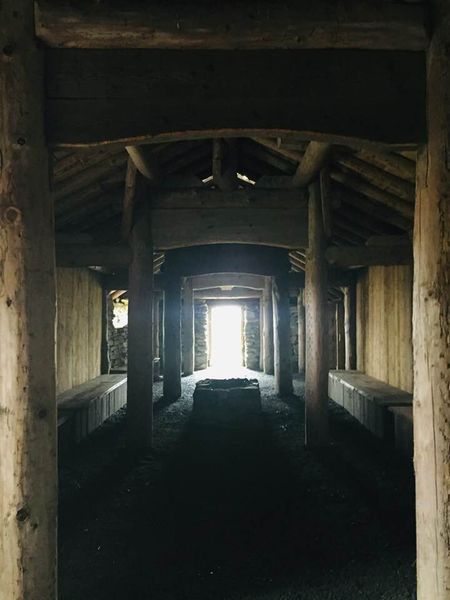
Day 19 – A day of rest and taking tea with the oyster catchers on this eve of the Feast of Mary of Egypt, one of my favourite saints and Desert Mothers. Mary was a pilgrim who travelled to Jerusalem from her home in Alexandria, possibly in the fifth century, and then into the desert as a hermit for many years. She is one of several saints who was buried with the help of a passing lion… a recurring motif that particularly appeals to me! (Note to loved ones… please arrange this for my funeral.)
The complexity of journey, of pilgrimage and the tales we tell about it has been on my mind, as have other, past travelers to Shetland. This isle of Unst has the highest density of rural Viking sites anywhere in the world and I have been visiting a number of sites over the days I have been here, including this replica Viking Longhouse at Haroldswick and nearby replica of the Gokstad ship found in a burial mound in Norway. I found it surprisingly stirring to stand in hall and ship beside a wild sea.

Day 20 – Yesterday and just a few words… after walking for hours on a puffin quest at the vast Hermaness Nature Reserve on the most northerly end of this most northerly isle. I didn’t find puffins (it’s still early for them it seems) but I did find many wonders, including thousands of gannets! The panoramic image above shows all the way from the gannetry, to the final northern islands of the UK, Muckle Flugga with its lighthouse and Out Stack (next stop the North Pole!). This photo also gives a good sense of the shifting weather…
I’m off to the neighbouring isle of Fetlar to a retreat house tomorrow (Day 22), before returning to Unst for a solitary retreat in Britain’s most northerly monastery…
All text and images are my own – © Sam Wernham 2023


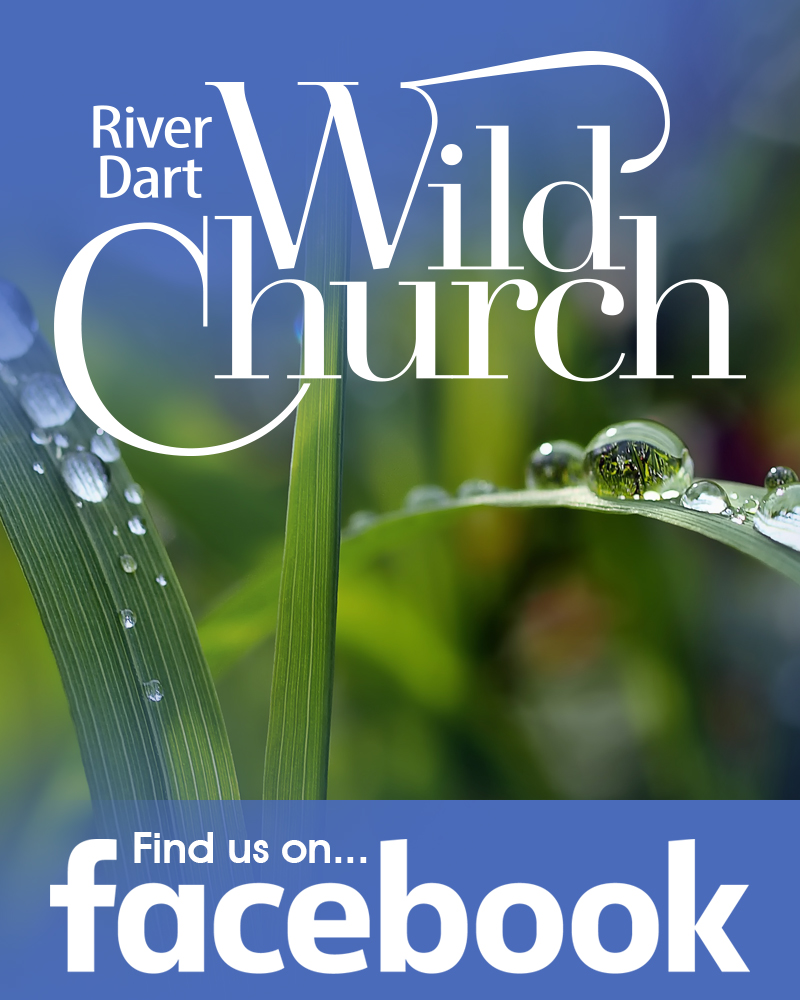

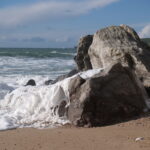
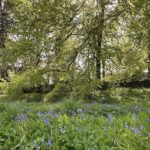

Leave a Reply